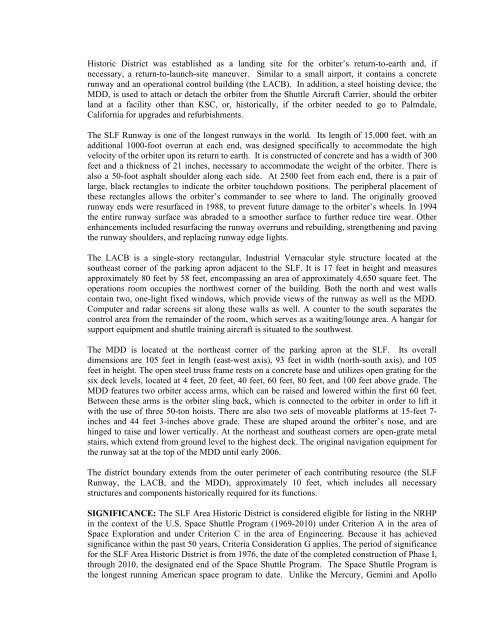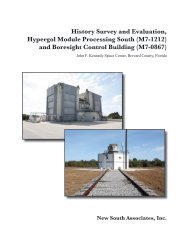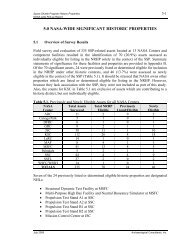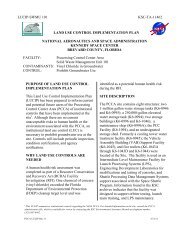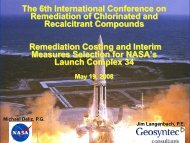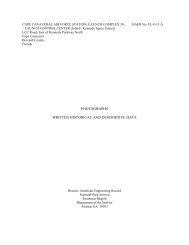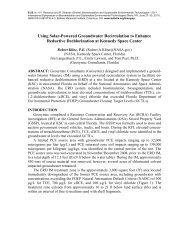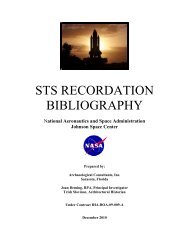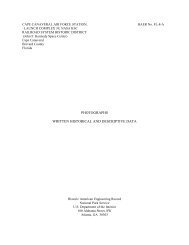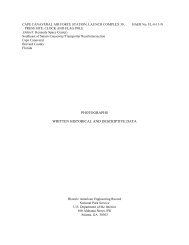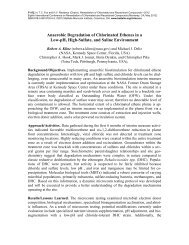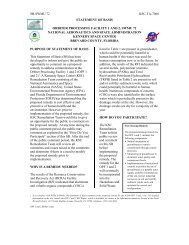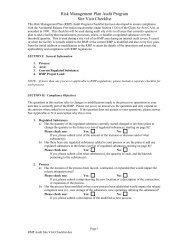john f. kennedy space center brevard county, florida - Environmental ...
john f. kennedy space center brevard county, florida - Environmental ...
john f. kennedy space center brevard county, florida - Environmental ...
Create successful ePaper yourself
Turn your PDF publications into a flip-book with our unique Google optimized e-Paper software.
Historic District was established as a landing site for the orbiter’s return-to-earth and, if<br />
necessary, a return-to-launch-site maneuver. Similar to a small airport, it contains a concrete<br />
runway and an operational control building (the LACB). In addition, a steel hoisting device, the<br />
MDD, is used to attach or detach the orbiter from the Shuttle Aircraft Carrier, should the orbiter<br />
land at a facility other than KSC, or, historically, if the orbiter needed to go to Palmdale,<br />
California for upgrades and refurbishments.<br />
The SLF Runway is one of the longest runways in the world. Its length of 15,000 feet, with an<br />
additional 1000-foot overrun at each end, was designed specifically to accommodate the high<br />
velocity of the orbiter upon its return to earth. It is constructed of concrete and has a width of 300<br />
feet and a thickness of 21 inches, necessary to accommodate the weight of the orbiter. There is<br />
also a 50-foot asphalt shoulder along each side. At 2500 feet from each end, there is a pair of<br />
large, black rectangles to indicate the orbiter touchdown positions. The peripheral placement of<br />
these rectangles allows the orbiter’s commander to see where to land. The originally grooved<br />
runway ends were resurfaced in 1988, to prevent future damage to the orbiter’s wheels. In 1994<br />
the entire runway surface was abraded to a smoother surface to further reduce tire wear. Other<br />
enhancements included resurfacing the runway overruns and rebuilding, strengthening and paving<br />
the runway shoulders, and replacing runway edge lights.<br />
The LACB is a single-story rectangular, Industrial Vernacular style structure located at the<br />
southeast corner of the parking apron adjacent to the SLF. It is 17 feet in height and measures<br />
approximately 80 feet by 58 feet, encompassing an area of approximately 4,650 square feet. The<br />
operations room occupies the northwest corner of the building. Both the north and west walls<br />
contain two, one-light fixed windows, which provide views of the runway as well as the MDD.<br />
Computer and radar screens sit along these walls as well. A counter to the south separates the<br />
control area from the remainder of the room, which serves as a waiting/lounge area. A hangar for<br />
support equipment and shuttle training aircraft is situated to the southwest.<br />
The MDD is located at the northeast corner of the parking apron at the SLF. Its overall<br />
dimensions are 105 feet in length (east-west axis), 93 feet in width (north-south axis), and 105<br />
feet in height. The open steel truss frame rests on a concrete base and utilizes open grating for the<br />
six deck levels, located at 4 feet, 20 feet, 40 feet, 60 feet, 80 feet, and 100 feet above grade. The<br />
MDD features two orbiter access arms, which can be raised and lowered within the first 60 feet.<br />
Between these arms is the orbiter sling back, which is connected to the orbiter in order to lift it<br />
with the use of three 50-ton hoists. There are also two sets of moveable platforms at 15-feet 7-<br />
inches and 44 feet 3-inches above grade. These are shaped around the orbiter’s nose, and are<br />
hinged to raise and lower vertically. At the northeast and southeast corners are open-grate metal<br />
stairs, which extend from ground level to the highest deck. The original navigation equipment for<br />
the runway sat at the top of the MDD until early 2006.<br />
The district boundary extends from the outer perimeter of each contributing resource (the SLF<br />
Runway, the LACB, and the MDD), approximately 10 feet, which includes all necessary<br />
structures and components historically required for its functions.<br />
SIGNIFICANCE: The SLF Area Historic District is considered eligible for listing in the NRHP<br />
in the context of the U.S. Space Shuttle Program (1969-2010) under Criterion A in the area of<br />
Space Exploration and under Criterion C in the area of Engineering. Because it has achieved<br />
significance within the past 50 years, Criteria Consideration G applies. The period of significance<br />
for the SLF Area Historic District is from 1976, the date of the completed construction of Phase I,<br />
through 2010, the designated end of the Space Shuttle Program. The Space Shuttle Program is<br />
the longest running American <strong>space</strong> program to date. Unlike the Mercury, Gemini and Apollo


